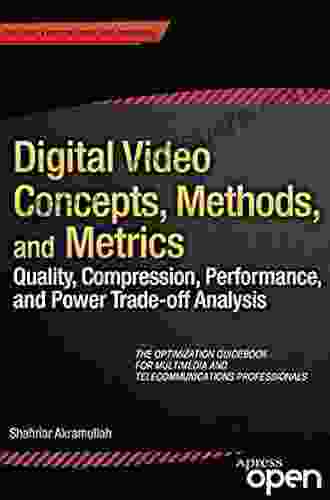Quality Compression Performance and Power Trade-Off Analysis: A Comprehensive Guide

4.3 out of 5
| Language | : | English |
| File size | : | 9340 KB |
| Text-to-Speech | : | Enabled |
| Screen Reader | : | Supported |
| Enhanced typesetting | : | Enabled |
| Print length | : | 459 pages |
In the era of digital multimedia, efficient compression techniques play a crucial role in reducing the size of digital content while maintaining acceptable quality. This is particularly important for applications such as image and video transmission, storage, and streaming, where bandwidth and storage constraints are significant.
However, achieving high compression ratios often comes at the expense of image quality. Additionally, some compression techniques require significant computational power, leading to increased power consumption. Therefore, it is essential to carefully consider the trade-offs between quality, compression performance, and power consumption when selecting a compression technique.
Quality Compression Performance Analysis
Quality compression performance analysis involves evaluating the impact of different compression techniques on image quality. The most common metric for assessing image quality is the peak signal-to-noise ratio (PSNR),which measures the difference between the original image and the compressed image. A higher PSNR indicates better image quality.
Other metrics for evaluating image quality include the mean squared error (MSE),the structural similarity index (SSIM),and the visual information fidelity (VIF). These metrics provide different perspectives on image quality, capturing various aspects such as pixel-by-pixel differences, structural similarities, and perceptual fidelity.
Power Consumption Analysis
Power consumption analysis involves measuring the amount of power consumed by a compression algorithm during the compression and decompression processes. Power consumption is typically measured in watts (W) or милливаттs (mW). Factors that affect power consumption include the complexity of the compression algorithm, the size of the image being compressed, and the hardware platform used for compression.
Quality-Compression-Power Trade-Offs
The quality-compression-power trade-offs refer to the relationship between image quality, compression performance, and power consumption. In general, higher compression ratios lead to lower image quality and higher power consumption. This is because more complex compression algorithms are required to achieve higher compression ratios, which in turn consume more power.
Therefore, it is important to find the optimal balance between quality, compression performance, and power consumption based on the specific application requirements. For example, in applications where image quality is paramount, a lossless compression technique may be preferred, even if it results in a lower compression ratio and higher power consumption.
Factors Influencing Quality-Compression-Power Trade-Offs
Several factors influence the quality-compression-power trade-offs, including:
- Compression Algorithm: Different compression algorithms have different characteristics in terms of quality, compression performance, and power consumption. Lossless compression algorithms preserve the original image data, resulting in better image quality but lower compression ratios. Lossy compression algorithms discard some of the original image data, resulting in lower image quality but higher compression ratios.
- Image Characteristics: The characteristics of the image being compressed can also affect the quality-compression-power trade-offs. Images with complex textures and details require more complex compression algorithms to achieve good quality, which can lead to higher power consumption.
- Hardware Platform: The hardware platform used for compression can also impact the quality-compression-power trade-offs. Hardware with faster processors and more efficient memory can handle more complex compression algorithms, resulting in better quality and higher compression ratios, but potentially at the expense of higher power consumption.
Applications of Quality Compression Performance and Power Trade-Off Analysis
Quality compression performance and power trade-off analysis is applied in a wide range of applications, including:
- Image and Video Transmission: In applications such as video conferencing and streaming, it is important to find the optimal balance between image quality, compression performance, and power consumption to ensure a smooth and efficient transmission.
- Image and Video Storage: For applications such as digital cameras and storage devices, it is important to consider the quality-compression-power trade-offs to determine the most appropriate compression technique for storing images and videos.
- Embedded Systems: In embedded systems with limited resources, it is crucial to carefully analyze the quality-compression-power trade-offs to select a compression technique that meets the performance and power constraints.
Quality compression performance and power trade-off analysis is a critical aspect of multimedia compression. By understanding the impact of different compression techniques on image quality, compression performance, and power consumption, it is possible to select the optimal compression technique for specific application requirements. This analysis helps ensure that the desired level of image quality is achieved while minimizing compression artifacts and power consumption.
As technology continues to advance, new compression techniques are being developed that offer improved quality, compression performance, and power efficiency. It is important to stay up-to-date with the latest developments in compression technology to take advantage of these advancements and optimize multimedia applications.
4.3 out of 5
| Language | : | English |
| File size | : | 9340 KB |
| Text-to-Speech | : | Enabled |
| Screen Reader | : | Supported |
| Enhanced typesetting | : | Enabled |
| Print length | : | 459 pages |
Do you want to contribute by writing guest posts on this blog?
Please contact us and send us a resume of previous articles that you have written.
 Fiction
Fiction Non Fiction
Non Fiction Romance
Romance Mystery
Mystery Thriller
Thriller SciFi
SciFi Fantasy
Fantasy Horror
Horror Biography
Biography Selfhelp
Selfhelp Business
Business History
History Classics
Classics Poetry
Poetry Childrens
Childrens Young Adult
Young Adult Educational
Educational Cooking
Cooking Travel
Travel Lifestyle
Lifestyle Spirituality
Spirituality Health
Health Fitness
Fitness Technology
Technology Science
Science Arts
Arts Crafts
Crafts DIY
DIY Gardening
Gardening Petcare
Petcare Gina Chen
Gina Chen Md Rezowan Ahmed
Md Rezowan Ahmed Julie Mosier
Julie Mosier Dmv Test Bank
Dmv Test Bank John Jacobs
John Jacobs Tyler Simmons
Tyler Simmons Sarah Woodbury
Sarah Woodbury Peter Worley
Peter Worley C L Simchick
C L Simchick American Baseball Coaches Association
American Baseball Coaches Association Chloe Gong
Chloe Gong Michelle Newhart
Michelle Newhart Julie Schacht Sway
Julie Schacht Sway American Math Academy
American Math Academy Don Bowers
Don Bowers Jean Van T Hul
Jean Van T Hul Brian Kateman
Brian Kateman Randall E Schumacker
Randall E Schumacker Bill Carter
Bill Carter Desi Northup
Desi Northup Christina Kamp
Christina Kamp Erin Chack
Erin Chack Nicholeen Peck
Nicholeen Peck Tijan
Tijan Pav Bryan
Pav Bryan Gal Dem
Gal Dem Paul Kockelman
Paul Kockelman Kevin Stiegelmaier
Kevin Stiegelmaier Paul Wieland
Paul Wieland David Elkington
David Elkington Julie Caplin
Julie Caplin Rachel Gurevich
Rachel Gurevich Michael R Poll
Michael R Poll Lisa Zimmer Hatch
Lisa Zimmer Hatch Marina Robb
Marina Robb Charles Thompson
Charles Thompson Martin Williams
Martin Williams Cheri Rae
Cheri Rae Amy Brown
Amy Brown Jonathon Miller Weisberger
Jonathon Miller Weisberger Ananda Lowe
Ananda Lowe Eric Zweig
Eric Zweig Jim Santos
Jim Santos Naomi Oreskes
Naomi Oreskes Amy Adele Hasinoff
Amy Adele Hasinoff Antonio R Damasio
Antonio R Damasio Stanley J Farlow
Stanley J Farlow Joe E Harvey
Joe E Harvey Donovan Hohn
Donovan Hohn John Lukacs
John Lukacs Gary Wiener
Gary Wiener Michael Winkelman
Michael Winkelman Pamela Lynn
Pamela Lynn Denise Ni
Denise Ni Sharon K Zumbrunn
Sharon K Zumbrunn Ken Chaddock
Ken Chaddock Autumn Jordon
Autumn Jordon Roman Gelperin
Roman Gelperin Sue Monk Kidd
Sue Monk Kidd Marit Weisenberg
Marit Weisenberg Amie Lands
Amie Lands Amit Saha
Amit Saha Holly Herrick
Holly Herrick Amy Perry
Amy Perry Anne Chambers
Anne Chambers Stanley I Greenspan
Stanley I Greenspan Brendan Leonard
Brendan Leonard Michael Abayomi
Michael Abayomi Laekan Zea Kemp
Laekan Zea Kemp Jon Bonnell
Jon Bonnell Rick Stanton
Rick Stanton Marisa Anne Bass
Marisa Anne Bass Joe Nickell
Joe Nickell Rich Rousseau
Rich Rousseau Cynthia Gabriel
Cynthia Gabriel Kyle Hunt
Kyle Hunt Johan Norberg
Johan Norberg Spike Dykes
Spike Dykes Chad Ford
Chad Ford Edward J Denecke
Edward J Denecke Oscar Baechler
Oscar Baechler Laura Slinn
Laura Slinn Ruth Nestvold
Ruth Nestvold E T Bryant
E T Bryant Donna Williams
Donna Williams Jan Marie Mueller
Jan Marie Mueller Rodney M Howard Browne
Rodney M Howard Browne Frederick Lenz
Frederick Lenz David Yoon
David Yoon Amby Cooper
Amby Cooper Trent Shelton
Trent Shelton Alan I Marcus
Alan I Marcus Rosanna Davison
Rosanna Davison Tavi Gevinson
Tavi Gevinson Temple Grandin
Temple Grandin Alex Polyakov
Alex Polyakov Don Stradley
Don Stradley June Cl Tan
June Cl Tan Joseph Howse
Joseph Howse Stephenie Meyer
Stephenie Meyer Ruta Nonacs
Ruta Nonacs Nikhil Bhardwaj
Nikhil Bhardwaj Suzanne Stabile
Suzanne Stabile Rob Antoun
Rob Antoun Kris Leonard
Kris Leonard Amelia Parker
Amelia Parker David Grinspoon
David Grinspoon Ana And Jack Hicks
Ana And Jack Hicks Louise Bates Ames
Louise Bates Ames Ronda Rousey
Ronda Rousey Philippa Langley
Philippa Langley Andy Couturier
Andy Couturier Gail Maccoll
Gail Maccoll Jack Nisbet
Jack Nisbet Umer W
Umer W Ned Vizzini
Ned Vizzini Joseph Conrad
Joseph Conrad Jessica Hatcher Moore
Jessica Hatcher Moore Joe Dante
Joe Dante Cookie O Gorman
Cookie O Gorman Christopher Harlan
Christopher Harlan Amira Mikhail
Amira Mikhail Anna B Doe
Anna B Doe Kathleen M Stacy
Kathleen M Stacy Mike Adamick
Mike Adamick P Aarne Vesilind
P Aarne Vesilind Laurie A Watkins
Laurie A Watkins Stephen Goodwin
Stephen Goodwin Robert Melillo
Robert Melillo Jan E Stets
Jan E Stets Andy Hunt
Andy Hunt Ashley Scott
Ashley Scott Jack Weatherford
Jack Weatherford Ruth M Tappen
Ruth M Tappen Randy Schultz
Randy Schultz Marshall Goldsmith
Marshall Goldsmith Jennifer S Kelly
Jennifer S Kelly Mark Turley
Mark Turley Steven C Hayes
Steven C Hayes Courtney Defeo
Courtney Defeo Victoria Richards
Victoria Richards Ray Mancini
Ray Mancini Amy Camp
Amy Camp Matthew Lombardi
Matthew Lombardi Dolores Kong
Dolores Kong A Sorority Of Mothers
A Sorority Of Mothers Mac Fortner
Mac Fortner Jameson M Wetmore
Jameson M Wetmore American Psychological Association
American Psychological Association Md Mahady Hasan
Md Mahady Hasan Diane Greer
Diane Greer Dr Elizabeth Cherevaty Nd Rac
Dr Elizabeth Cherevaty Nd Rac Theresa Y Wee M D
Theresa Y Wee M D Erika Napoletano
Erika Napoletano Zeshan Qureshi
Zeshan Qureshi Derek Thompson
Derek Thompson Shaun Gallagher
Shaun Gallagher Thomas J Whalen
Thomas J Whalen John Bingham
John Bingham Jenni Hicks
Jenni Hicks Jocelyn Goodwin
Jocelyn Goodwin Matthew L Martin
Matthew L Martin Paul Schwartz
Paul Schwartz Amelia Freer
Amelia Freer Eric E Bowne
Eric E Bowne Muhammad Vandestra
Muhammad Vandestra Sandra T Barnes
Sandra T Barnes Meikang Qiu
Meikang Qiu Tim Hornbaker
Tim Hornbaker Jd Mader
Jd Mader Shere Hite
Shere Hite John Ferrell
John Ferrell J Stephen Jones
J Stephen Jones Philip Gibson
Philip Gibson Terry Wieland
Terry Wieland Camille Glenn
Camille Glenn Sian Warriner
Sian Warriner Anthony Haynes
Anthony Haynes Cathy Williams
Cathy Williams Arlene Blum
Arlene Blum Robyn Davidson
Robyn Davidson Don Orwell
Don Orwell Glenn Stout
Glenn Stout Tom Patri
Tom Patri Therese A Rando
Therese A Rando Mitt Romney
Mitt Romney Michael Reichert
Michael Reichert J Marin Younker
J Marin Younker Kresley Cole
Kresley Cole Tim Marshall
Tim Marshall Jessica Cunsolo
Jessica Cunsolo Amara Charles
Amara Charles William Rosen
William Rosen Joe Dan Lowry
Joe Dan Lowry Rosalind Wiseman
Rosalind Wiseman Amrita Pande
Amrita Pande Nick Kolenda
Nick Kolenda Kathy Spratt
Kathy Spratt Redmond O Hanlon
Redmond O Hanlon James P Kelly
James P Kelly Nina Freudenberger
Nina Freudenberger Dan Abnett
Dan Abnett Steven Charleston
Steven Charleston Shanna Cunning
Shanna Cunning Eugenia Viti
Eugenia Viti Paul Kaplowitz
Paul Kaplowitz Theodore Sider
Theodore Sider Amy B Middleman
Amy B Middleman Christopher Cousteau
Christopher Cousteau Ignatius Donnelly
Ignatius Donnelly Pinky Mckay
Pinky Mckay Amelia Edith Huddleston Barr
Amelia Edith Huddleston Barr Joseph P Weir
Joseph P Weir Sean Gibson
Sean Gibson Sean Go
Sean Go Sarah Morgan Haydock
Sarah Morgan Haydock Eric T Knight
Eric T Knight Stephen Walker
Stephen Walker Gerald Corey
Gerald Corey Nicholas A Christakis
Nicholas A Christakis Michael Parker Pearson
Michael Parker Pearson Jenny Landreth
Jenny Landreth Sandra Luna Mccune
Sandra Luna Mccune Fred Pyrczak
Fred Pyrczak Tom Colicchio
Tom Colicchio Rick Deutsch
Rick Deutsch Douglas Wilson
Douglas Wilson Silvia Botros
Silvia Botros Nisha Garg
Nisha Garg The 60 Minutes Summary
The 60 Minutes Summary Harley Reid
Harley Reid Amante P Marinas
Amante P Marinas Trevor Day
Trevor Day Robert A Weinberg
Robert A Weinberg Laini Taylor
Laini Taylor Summer Michaud Skog
Summer Michaud Skog Iain Pardoe
Iain Pardoe Stephen Barr
Stephen Barr John Mcpherson
John Mcpherson Bruce Dowbiggin
Bruce Dowbiggin Nikala Smith
Nikala Smith Vicki Hearne
Vicki Hearne Howard J Meditz
Howard J Meditz Wolf Moon
Wolf Moon Deborah Lipsky
Deborah Lipsky David Guymer
David Guymer Jennifer Margulis
Jennifer Margulis Wendy Margolis
Wendy Margolis Elizabeth S Gilbert
Elizabeth S Gilbert Bethanne Kim
Bethanne Kim Catherine Dees
Catherine Dees Jayson Gaddis
Jayson Gaddis Cordelia K Castel
Cordelia K Castel Craig Larman
Craig Larman Lady Antiva
Lady Antiva William Stillman
William Stillman Kathleen Glasgow
Kathleen Glasgow Alexandrea Weis
Alexandrea Weis Bridget Ericsson
Bridget Ericsson Joseph Wayne Smith
Joseph Wayne Smith Leslie Sansone
Leslie Sansone Nathan Belofsky
Nathan Belofsky Byron Nelson
Byron Nelson Marco Ferrero
Marco Ferrero Traci Gormley
Traci Gormley Helena P Blavasky
Helena P Blavasky Jason Borte
Jason Borte Susanna Heli
Susanna Heli David Ranney
David Ranney Tamora Pierce
Tamora Pierce Ellie Wood
Ellie Wood Alex Stone
Alex Stone Martin Pollizotto
Martin Pollizotto Sarah J Maas
Sarah J Maas Amber Smith
Amber Smith Jeremy J Baumberg
Jeremy J Baumberg James Mullaney
James Mullaney Art Star
Art Star Amiee Mueller
Amiee Mueller Jeffrey Steadman
Jeffrey Steadman Jean Rose
Jean Rose Paul Dickson
Paul Dickson Dom Amore
Dom Amore Doug Peterson
Doug Peterson J L Weil
J L Weil Gia Giasullo
Gia Giasullo Django Paris
Django Paris Robert W D Ball
Robert W D Ball Chad Starkey
Chad Starkey Paul Graham
Paul Graham George Bernard Shaw
George Bernard Shaw Patricia L Papernow
Patricia L Papernow Jean Christie Ashmore
Jean Christie Ashmore Thom Hartmann
Thom Hartmann Vivian Vande Velde
Vivian Vande Velde Paul Oliver
Paul Oliver Richard Cohen
Richard Cohen Sheri Van Dijk
Sheri Van Dijk Charles Hall
Charles Hall Kristine Kathryn Rusch
Kristine Kathryn Rusch Jerry D Moore
Jerry D Moore Valerie Bass
Valerie Bass Brian Pace
Brian Pace Emma Mae Jenkins
Emma Mae Jenkins Heidi J Larson
Heidi J Larson Melody Schreiber
Melody Schreiber Kenneth P Stephens
Kenneth P Stephens Erik Qualman
Erik Qualman Amber Foster
Amber Foster Heather Macfadyen
Heather Macfadyen Garrett M Fitzmaurice
Garrett M Fitzmaurice Shannon O Bourne
Shannon O Bourne Dr Scott A Johnson
Dr Scott A Johnson Jacob Bronowski
Jacob Bronowski Timothy Malcolm
Timothy Malcolm Sarah Sumbal
Sarah Sumbal Joseph Mcmoneagle
Joseph Mcmoneagle Henry A Zumbrun 2
Henry A Zumbrun 2 Andy Singleton
Andy Singleton Guillaume Haeringer
Guillaume Haeringer Theresa I Soto
Theresa I Soto Tom Taulli
Tom Taulli Joellen Patterson
Joellen Patterson Janet Engle
Janet Engle Dima Zales
Dima Zales Mark Stallard
Mark Stallard Lisa Maloney
Lisa Maloney Sonia Hartl
Sonia Hartl Michaela Riva Gaaserud
Michaela Riva Gaaserud Jack Falla
Jack Falla Michael Cosgrove
Michael Cosgrove Kumo Kagyu
Kumo Kagyu Jonathan Law
Jonathan Law Hadley Wickham
Hadley Wickham Patrick O Sullivan
Patrick O Sullivan Shalabh Aggarwal
Shalabh Aggarwal Danny Dreyer
Danny Dreyer Toni Tone
Toni Tone Krystal Sutherland
Krystal Sutherland Amy Mccready
Amy Mccready Victoria Wood
Victoria Wood Kate Fox
Kate Fox Elizabeth Lim
Elizabeth Lim Lars Andersen
Lars Andersen Michael Ondaatje
Michael Ondaatje Swede Burns
Swede Burns Amber Lia
Amber Lia Joseph Klaits
Joseph Klaits William Glasser M D
William Glasser M D Christine Fanthome
Christine Fanthome Clancy Cavnar
Clancy Cavnar Victor J Stenger
Victor J Stenger Tracy Lorraine
Tracy Lorraine Liz Fosslien
Liz Fosslien Amir Alexander
Amir Alexander Jeff Martone
Jeff Martone Joel Cotton
Joel Cotton Kieron Gillen
Kieron Gillen Claudia J Carr
Claudia J Carr H Bedford Jones
H Bedford Jones Helen E Fisher
Helen E Fisher Susan White
Susan White William Bohan
William Bohan Carlo Buzzichelli
Carlo Buzzichelli Dave Hanson
Dave Hanson Wade Rouse
Wade Rouse Kathy A Zahler
Kathy A Zahler Reinhold Messner
Reinhold Messner Sandra Bardwell
Sandra Bardwell Mariano Anaya
Mariano AnayaK D
 Neville Goddard
Neville Goddard Cole Hersowitz
Cole Hersowitz Julie Barlow
Julie Barlow Dana Obleman
Dana Obleman Kezia Endsley
Kezia Endsley Josh Taylor
Josh Taylor Amy Baldwin
Amy Baldwin John A Buehrens
John A Buehrens Chris Carlsson
Chris Carlsson Deborah Vinall Psyd Lmft
Deborah Vinall Psyd Lmft Dr Bob Rotella
Dr Bob Rotella Adam Cort
Adam Cort Derrick Jensen
Derrick Jensen Karen Deerwester
Karen Deerwester William G Dever
William G Dever Stephen M Barr
Stephen M Barr Tanya Turner
Tanya Turner Kate Tietje
Kate Tietje Brittany Clair
Brittany Clair Charles J Alsheimer
Charles J Alsheimer Tabitha Suzuma
Tabitha Suzuma Isabella Krystynek
Isabella Krystynek Peter Hayes
Peter Hayes Warren B Powell
Warren B Powell Jason Thompson
Jason Thompson Eric Tyndall
Eric Tyndall Kate Parham Kordsmeier
Kate Parham Kordsmeier Larry K Brendtro
Larry K Brendtro Sheena Johnstone
Sheena Johnstone Malba Tahan
Malba Tahan Sterling Test Prep
Sterling Test Prep Rob Fisher
Rob Fisher Kasie West
Kasie West John Maxwell Wood
John Maxwell Wood Grant Dever
Grant Dever Josiah Hesse
Josiah Hesse Don Mann
Don Mann Candy Verney
Candy Verney Ned Seaton
Ned Seaton Test Masters
Test Masters David Burch
David Burch Norman Doidge
Norman Doidge Erica T Lehrer
Erica T Lehrer Maria Youtman
Maria Youtman Amber Lee Sellers
Amber Lee Sellers Rose Mannering
Rose Mannering Amy Blakeslee
Amy Blakeslee Christopher E Larsen
Christopher E Larsen Steve Greenberg
Steve Greenberg Jack Ewing
Jack Ewing Topher Donahue
Topher Donahue Vince Kotchian
Vince Kotchian Jeff Gaudette
Jeff Gaudette Pico Iyer
Pico Iyer James W Williams
James W Williams Amber O Neal Johnston
Amber O Neal Johnston James E Packer
James E Packer Buck Tilton
Buck Tilton Amy Bizzarri
Amy Bizzarri Jack Freeman
Jack Freeman Brian Klaas
Brian Klaas Catherine Ryan Gregory
Catherine Ryan Gregory David Salsburg
David Salsburg Vinod Kumar Khanna
Vinod Kumar Khanna Mark Worden
Mark Worden Angela Moore
Angela Moore Jack Tupp
Jack Tupp Candida Lawrence
Candida Lawrence Dan Schlossberg
Dan Schlossberg Lizabeth Hardman
Lizabeth Hardman Alan Margot
Alan Margot Tahlia Kirk
Tahlia Kirk Jeanne Ryan
Jeanne Ryan Jonathan Bartlett
Jonathan Bartlett C W Lockhart
C W Lockhart Amy Bleuel
Amy Bleuel Mark Taylor
Mark Taylor Cody Monk
Cody Monk Peter Larson
Peter Larson Mark W T Harvey
Mark W T Harvey Elise Christie
Elise Christie Josephine Atluri
Josephine Atluri Robb Walsh
Robb Walsh Anthony Horowitz
Anthony Horowitz Chris Irons
Chris Irons Andrey Ryanskiy
Andrey Ryanskiy Clotaire Rapaille
Clotaire Rapaille Tom Deck
Tom Deck Saleh Alkhalifa
Saleh Alkhalifa Torey L Hayden
Torey L Hayden Amber Zygutis
Amber Zygutis Benjamin Jelen
Benjamin Jelen Stephen J Collier
Stephen J Collier John L Field
John L Field Devin Olsen
Devin Olsen Richard Wagamese
Richard Wagamese Deborah J Rumsey
Deborah J Rumsey Katherine Kurtz
Katherine Kurtz Frank Nappi
Frank Nappi L Frank Baum
L Frank Baum Sarah Dessen
Sarah Dessen Ryan Gray
Ryan Gray Jake Maddox
Jake Maddox Joan Freeman
Joan Freeman K M Shea
K M Shea Amie Kaufman
Amie Kaufman K F Breene
K F Breene Eugene C Toy
Eugene C Toy
Light bulbAdvertise smarter! Our strategic ad space ensures maximum exposure. Reserve your spot today!

 Michael ChabonAn Explorer's Guide to Lost Landscapes, Unsung Heroes, and Radical Histories
Michael ChabonAn Explorer's Guide to Lost Landscapes, Unsung Heroes, and Radical Histories
 Christian BarnesUnveiling the Enchanting Asia Folklore Tales of the Beautiful Maiden of Unai
Christian BarnesUnveiling the Enchanting Asia Folklore Tales of the Beautiful Maiden of Unai
 Chance Foster101 Ways To Make Studying Easier And Faster For High School Students: What...
Chance Foster101 Ways To Make Studying Easier And Faster For High School Students: What... Bryson HayesFollow ·17.5k
Bryson HayesFollow ·17.5k DeShawn PowellFollow ·9.4k
DeShawn PowellFollow ·9.4k Banana YoshimotoFollow ·13.5k
Banana YoshimotoFollow ·13.5k Jaime MitchellFollow ·5.6k
Jaime MitchellFollow ·5.6k Henry JamesFollow ·17.2k
Henry JamesFollow ·17.2k Pat MitchellFollow ·10.4k
Pat MitchellFollow ·10.4k Clarence BrooksFollow ·8.1k
Clarence BrooksFollow ·8.1k Leo TolstoyFollow ·18.7k
Leo TolstoyFollow ·18.7k

 Ira Cox
Ira CoxUnveiling the Hidden Gem: Moon, Virginia - A Washington...
Nestled within the picturesque...

 Jorge Luis Borges
Jorge Luis BorgesThe Ultimate Survivalist's Medical Guide: A Comprehensive...
In the realm of...

 Henry Green
Henry GreenDavid Douglas: Exploring the Natural History of the...
David Douglas was a...

 Eric Hayes
Eric HayesUnderstanding Citizenship in a Globalized World: A...
Citizenship is a complex and multifaceted...

 Will Ward
Will WardUnveiling Research Real Talk: Navigating the Labyrinth of...
Research, the...
4.3 out of 5
| Language | : | English |
| File size | : | 9340 KB |
| Text-to-Speech | : | Enabled |
| Screen Reader | : | Supported |
| Enhanced typesetting | : | Enabled |
| Print length | : | 459 pages |








